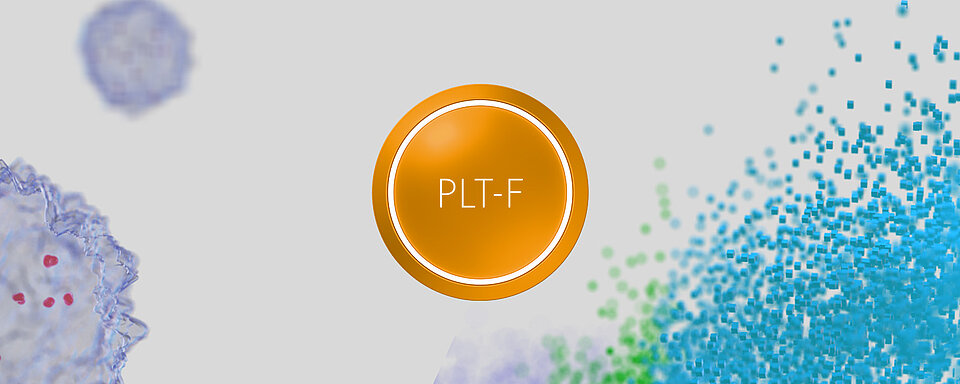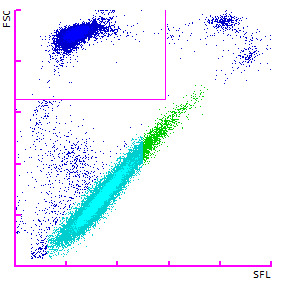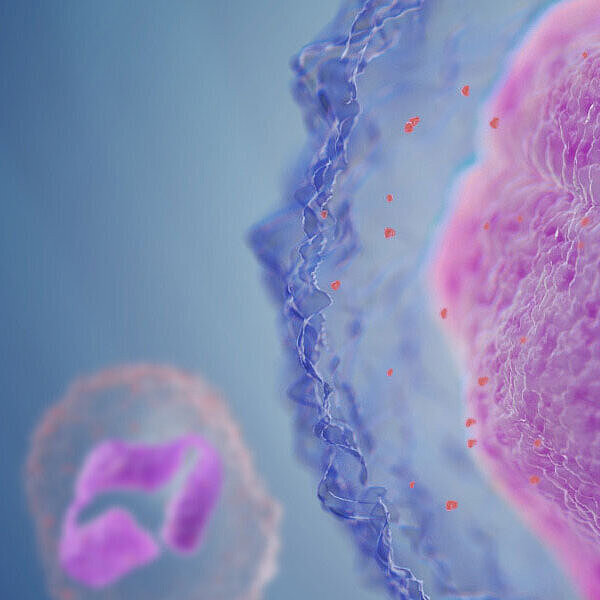The optional fluorescence platelet count application ‘PLT-F’
The PLT-F application available for XR-Series and XN-Series analysers was designed as a dedicated measurement channel to deliver accurate and precise platelet counts in routine haematology analysis – even with severely thrombocytopenic or otherwise challenging samples, such as interferences. A dedicated reagent combination was specifically designed to meet this purpose.
The fluorescence marker specifically labels platelets and none of the other blood cells. This minimises interferences and is the main reason for the extremely good correlation with the CD41/CD61 immune flow cytometry method*. Another reason for this is the high measurement accuracy in the low concentration range since the PLT-F channel analyses a fivefold volume of the aspirated sample compared to the standard DC detection measurement.
PLT-F analysis delivers a rapid and fully automated quantification of the immature platelet fraction (IPF and IPF#). The IPF parameters support a quick and efficient differential diagnosis of thrombocytopenia since they can be used by clinicians as an initial suggestion whether the possible cause lies in the bone marrow or in the peripheral blood*.
With severely thrombocytopenic samples and those with an action message regarding an unreliable platelet result measured by DC detection, the XN-Series’ and XR-Series’ rule sets automatically trigger the measurement of PLT-F as a reflex test. This makes sure that only samples needing that reflex test are measured in the PLT-F channel, ensuring an efficient and economical operation of the PLT-F application.
For patients with unclear thrombocytopenia, the optional TWO (Thrombopoiesis Workflow Optimisation) add-on of the Extended IPU triggers PLT-F analysis to make the clinically relevant information of the IPF parameter available. This automatic decision helps to standardise and streamline your entire platelet workflow, based on a fully customisable rule set.
PLT analysis with fluorescence flow cytometry
The membranes of the platelets are perforated by the lysing reagent, but the cells remain largely intact during this process. Subsequently, the fluorescence marker specifically labels the RNA inside the platelets, avoiding interferences with other cells or fragments of similar size. This is due to the labelling of cell organelles rich in nucleic acids, such as mitochondria and endoplasmic reticulum, rather than cell membranes.
Using the forward scattered light reflecting size and the fluorescence signal reflecting labelled nucleic acid content, the platelets are separated from red blood cells and white blood cells and are displayed accordingly in the PLT-F scattergram.
The PLT-F application also allows the rapid and fully automated quantification of the immature platelet fraction (IPF and IPF#). Immature platelets can be separated from mature platelets since they contain more RNA than mature ones reflected by increased fluorescence signals. Since they are also slightly larger, their forward scatter signal is also stronger than that of mature platelets.
The below figure shows the standard PLT-F scattergram with a normal cell distribution.
Benefits for laboratories and clinicians
-
With abnormalities and low counts, accurate and precise platelet counting becomes a challenge. Sysmex’s PLT-F application and platelet management concept ensure that a laboratory can report reliably, while streamlining their entire platelet workflow and reducing turnaround time. There is no longer the time-consuming need for counting platelets manually or by separate technologies and devices.
-
For samples with an inaccurate count caused by abnormalities or a very low platelet count, the XR-Series or XN-Series analyser automatically performs a reflex measurement in the dedicated platelet measurement channel PLT-F.
-
PLT-F analysis resolves most interferences present with DC detection since the fluorescence marker specifically labels platelets – so there’s no interference even in the presence of fragmented red blood cells. Falsely low counts due to giant platelets no longer occur with PLT-F analysis, and platelet clumps are detected in the PLT-F channel and pointed out by the analyser.
-
High precision prevails also at platelet transfusion thresholds, due to the fluorescence technology and 5-fold higher counting volume – this supports in making clinical decisions*.
-
Results are directly comparable to the reference immune flow cytometry method CD41/CD61. In many scientific research articles PLT-F was found to be highly correlative with this method*.
-
The immature platelet fraction IPF supports the differential diagnosis of thrombocytopenia*.
-
Aspiration volumes in whole blood mode are only 88 μL, and the PLT-F profile can even be analysed in the pre-diluted mode, which is particularly advantageous when measuring IPF from a neonate blood sample to support differential diagnosis of neonatal thrombocytopenia.
-
The immature platelet count IPF# enumerates the platelets most recently produced in bone marrow*.
-
The optional add-on TWO embedded in the Extended IPU supports the monitoring of thrombocytopenic patients and optimises PLT-F triggers to ensure comparable platelet results throughout the follow-up period.
* For references to independent publications, please visit our publications or contact your local Sysmex representative.
For Sysmex white papers, please visit our Scientific documents library.
Documents for download
-
Clinical information card: Managing immune thrombocytopenia (ITP) treatment effectivelyPDF (335 KB)
-
Clinical information card: Identifying poor antiplatelet drug response and its risks early onPDF (342 KB)
-
Clinical information card: Immediate support for determining the cause of thrombocytopeniaPDF (330 KB)
-
Lab card: The expert channel for platelet managementPDF (379 KB)
-
Lab card: Get the best platelet result for each sample without delayPDF (2 MB)





